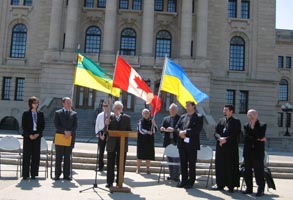April 29 a commemorative Holodomor famine-genocide program was held by the Regina branch of the UCC in front of the Saskatchewan Legislative Building.
Approximately 200 members of the community attended the program, which was opened by Master of Ceremonies Orest Warnyca, President of the Regina Branch of the UCC.
The Premier of Saskatchewan, Brad Wall, was there to greet flame bearer and Holodomor survivor, Horlatsch. In his greetings, Premier Wall stated “we in Saskatchewan, as much as anywhere on the planet, understand the amazing gift that the world was deprived of because of this famine and genocide, for we have been such significant benefactors of that gift — the gift of Ukrainian value and tradition and contribution. Those values are poured into the DNA of this province.”

Historical information on the Holodomor and a call to have such information included in the Saskatchewan school curriculum were provided by UCC Regina member Tricia Kaminski and UCC Saskatchewan president Ed Lysyk. Stefan Horlatsch, Ed Lysyk and Orest Warnyca were later acknowledged in the session of the Saskatchewan Legislature. During the session, members of the political parties made presentations recognizing the Holodomor as a famine-genocide in Ukraine.
The Regina event received considerable coverage in the Regina Leader-Post. The Leader-Post cited Horlatsch as saying it was important to remember the tragedy to ensure something like it would never happen again. As he spoke he held the remembrance torch as the Canadian, Saskatchewan, and Ukrainian flags flew behind him.
Horlatsch was 12 in 1932 and has vivid memories of the famine. When the famine-genocide began, Horlatsch and his family were living in Zaporizhia in the eastern region of Ukraine near the Black Sea. His family’s land, livestock and grain were seized by Soviet authorities. His father was sent to Siberia like most of the men during this time, wrote Leader-Post reporter Kerry Benjoe. Amazingly his mother singlehandedly saved all four of her children based solely on a premonition she had that something evil was about to happen.
“It was two or three years before Holodomor, she was baking bread and making bread crumbs out of it and hiding it in different places like the stable, in the house, many, many places,” recalled Horlatsch. “From time to time she was digging it out and we were using two or three spoons of bread crumbs with hot water and that’s what actually saved us.”
He said because many men were taken from their families it had a dire effect on the women and children. “My cousins they were living about three or four houses away from us. There were 11 of them in the family and all 11 of them died in 1933,” said Horlatsch. “I remember once when I went to visit them there were three already dead and the rest of them weren’t strong enough to bury them. It was winter time, and the ground was frozen, it wasn’t easy to dig the grave.”
The memories are still very difficult for him to recall because it was a very dark time for the Ukrainian people. “I can say many, many things but it’s not easy. It’s not easy to remember. It’s not easy to say,” said Horlatsch. “I hope one thing — that it will never happen anywhere in the world.”
The Ukrainian Canadian Congress estimates that one-third of Holodomor victims were children. In that short period of time, one-quarter of the Ukrainian population died. The genocide policy introduced by then-Soviet leader Joseph Stalin included confiscation of all food both inside and outside the homes. Ukrainian people were forced to stay within their communities, therefore making it impossible to search for food.
Lysyk said having the flame in Regina provided an opportunity not only to educate people but to call on the government to make changes to recognize this part of Ukrainian history. He said there is currently some information on Holodomor in the Grade 5 and Grade 11 social studies programs. “It’s not very specific. It just doesn’t provide a lot of facts and we would like them to consult with us and perhaps improve the materials they have and the information that they have so that really does inform youths correctly,” said Lysyk.